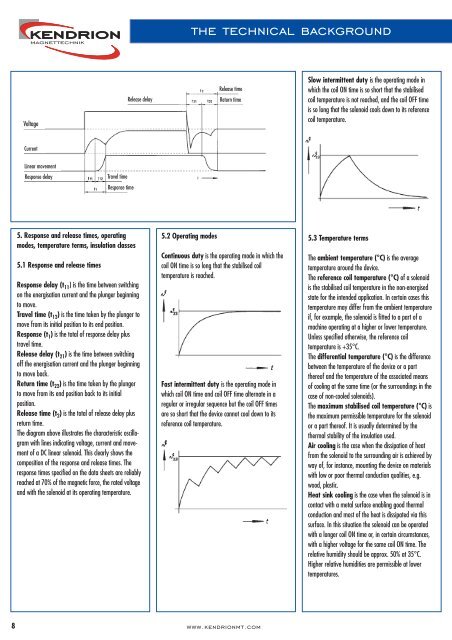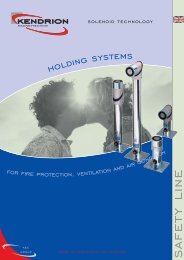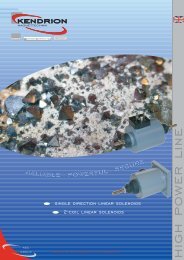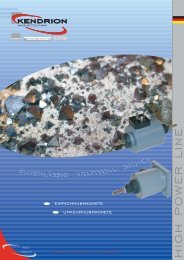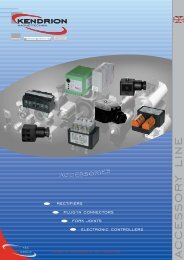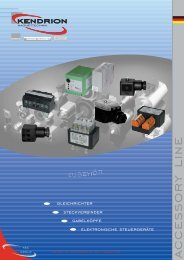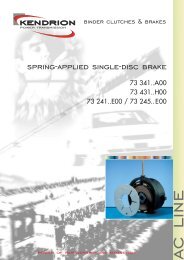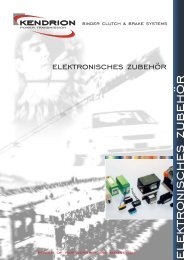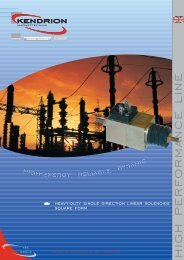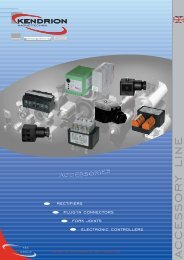Tech. Explanations - Kendrion Binder
Tech. Explanations - Kendrion Binder
Tech. Explanations - Kendrion Binder
Create successful ePaper yourself
Turn your PDF publications into a flip-book with our unique Google optimized e-Paper software.
the technical background<br />
Voltage<br />
Release delay<br />
Release time<br />
Return time<br />
Slow intermittent duty is the operating mode in<br />
which the coil ON time is so short that the stabilised<br />
coil temperature is not reached, and the coil OFF time<br />
is so long that the solenoid cools down to its reference<br />
coil temperature.<br />
Current<br />
Linear movement<br />
Response delay<br />
Travel time<br />
Response time<br />
5. Response and release times, operating<br />
modes, temperature terms, insulation classes<br />
5.1 Response and release times<br />
Response delay (t 11 ) is the time between switching<br />
on the energisation current and the plunger beginning<br />
to move.<br />
Travel time (t 12 ) is the time taken by the plunger to<br />
move from its initial position to its end position.<br />
Response (t 1 ) is the total of response delay plus<br />
travel time.<br />
Release delay (t 21 ) is the time between switching<br />
off the energisation current and the plunger beginning<br />
to move back.<br />
Return time (t 22 ) is the time taken by the plunger<br />
to move from its end position back to its initial<br />
position.<br />
Release time (t 2 ) is the total of release delay plus<br />
return time.<br />
The diagram above illustrates the characteristic oscillogram<br />
with lines indicating voltage, current and movement<br />
of a DC linear solenoid. This clearly shows the<br />
composition of the response and release times. The<br />
response times specified on the data sheets are reliably<br />
reached at 70% of the magnetic force, the rated voltage<br />
and with the solenoid at its operating temperature.<br />
5.2 Operating modes<br />
Continuous duty is the operating mode in which the<br />
coil ON time is so long that the stabilised coil<br />
temperature is reached.<br />
Fast intermittent duty is the operating mode in<br />
which coil ON time and coil OFF time alternate in a<br />
regular or irregular sequence but the coil OFF times<br />
are so short that the device cannot cool down to its<br />
reference coil temperature.<br />
5.3 Temperature terms<br />
The ambient temperature (°C) is the average<br />
temperature around the device.<br />
The reference coil temperature (°C) of a solenoid<br />
is the stabilised coil temperature in the non-energised<br />
state for the intended application. In certain cases this<br />
temperature may differ from the ambient temperature<br />
if, for example, the solenoid is fitted to a part of a<br />
machine operating at a higher or lower temperature.<br />
Unless specified otherwise, the reference coil<br />
temperature is +35°C.<br />
The differential temperature (°C) is the difference<br />
between the temperature of the device or a part<br />
thereof and the temperature of the associated means<br />
of cooling at the same time (or the surroundings in the<br />
case of non-cooled solenoids).<br />
The maximum stabilised coil temperature (°C) is<br />
the maximum permissible temperature for the solenoid<br />
or a part thereof. It is usually determined by the<br />
thermal stability of the insulation used.<br />
Air cooling is the case when the dissipation of heat<br />
from the solenoid to the surrounding air is achieved by<br />
way of, for instance, mounting the device on materials<br />
with low or poor thermal conduction qualities, e.g.<br />
wood, plastic.<br />
Heat sink cooling is the case when the solenoid is in<br />
contact with a metal surface enabling good thermal<br />
conduction and most of the heat is dissipated via this<br />
surface. In this situation the solenoid can be operated<br />
with a longer coil ON time or, in certain circumstances,<br />
with a higher voltage for the same coil ON time. The<br />
relative humidity should be approx. 50% at 35°C.<br />
Higher relative humidities are permissible at lower<br />
temperatures.<br />
8<br />
www.kendrionmt.com


